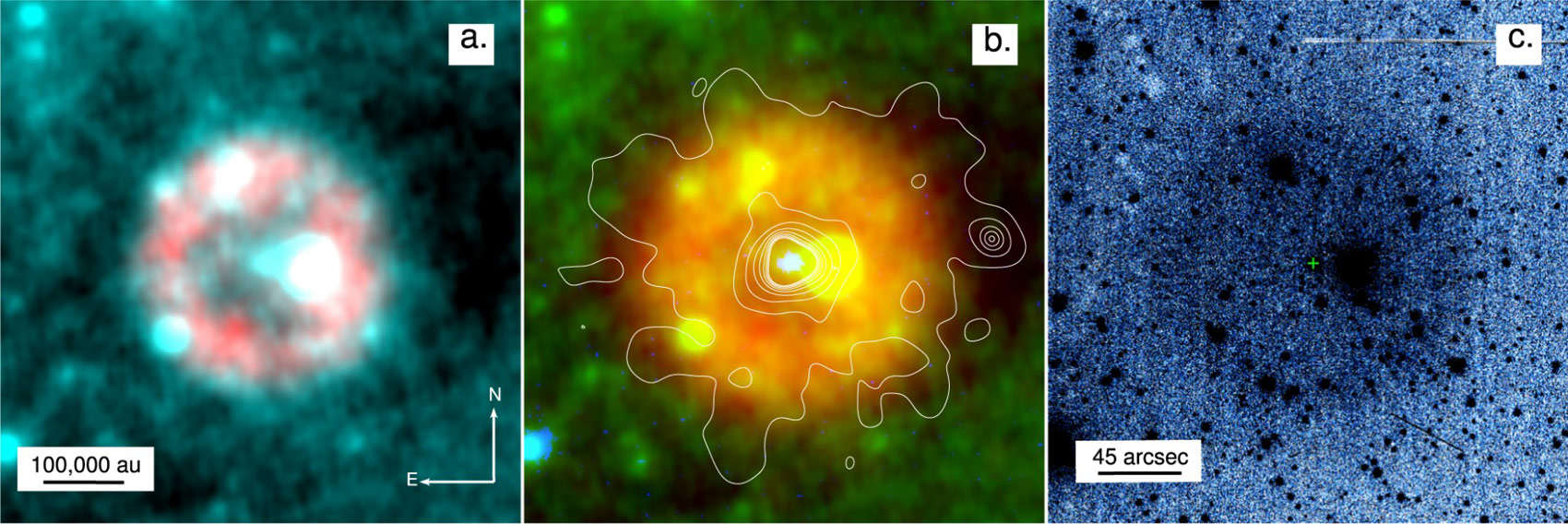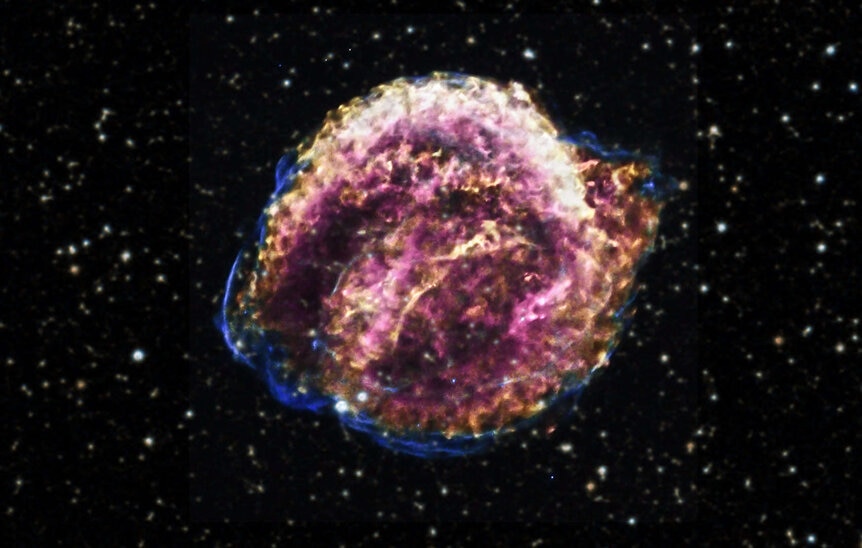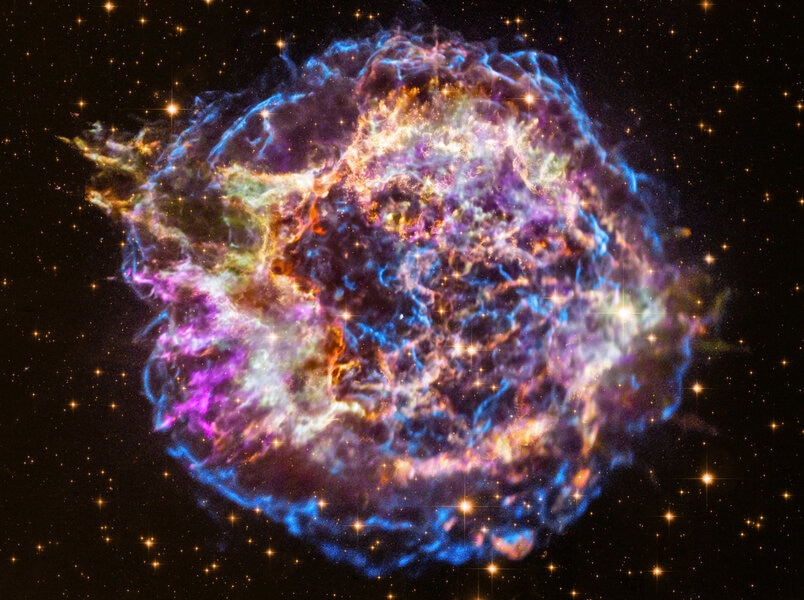Create a free profile to get unlimited access to exclusive videos, sweepstakes, and more!
The 900-year-old mystery of the missing supernova has finally been solved

A 900-year-old galactic mystery has been solved! The cold case of The Star That Appeared in the Night But Then Disappeared Without a Trace may finally have found its perp.
The story begins in 1181 CE. On August 6, Chinese and Japanese astronomers saw a "new" star in the sky, what they called a "Guest Star." It brightened over time before fading, getting about as bright as Saturn at its peak. In February 1182 it faded from view, having been visible to the unaided eye for six months.
This sounds very much like a supernova*, an exploding star. But when stars explode the expanding debris glows for millennia, yet no such supernova remnant has ever been seen for this 1181 Guest Star. One problem is that the astronomers of old didn't map the position of this new star terribly accurately relative to modern measurements, with different astronomers noting positions that were off by several degrees from one another. This area of the sky, in the constellation of Cassiopeia, is in the plane of the galaxy, so it's just littered with gas clouds, dust streamers, and stars, making an ID difficult.
Modern astronomers thought perhaps that an object called 3C 58 might fit the bill, since it looks like a supernova remnant and is close to that part of the sky. The problem is the age is likely several thousand years, so it's way too old.
So where is it? This has been an enduring mystery; Nine recorded supernovae have been seen historically up to the use of the telescope in the early 1600s, and about half have identified remnants (including the famous Crab Nebula, Cas A, Kepler's Supernova, and Tycho's Supernova). This sighting in 1181 CE is the only one in the past millennium not to have an associated nebula (literally, Latin for fog) with it.
But now we have a Nebula of Interest, and it's very much a prime suspect.
A group of amateur astronomers called the Deep Sky Hunters have been combing through survey catalogs of the sky looking for previously undetected objects. They've found literally hundreds of small, faint nebulae that had gone previously unnoticed. One of them, dubbed Pa 30, looks very much like it's the missing supernova remnant.
The nebula was first seen by Deep Sky Hunter Dana Patchick in 2013 (hence the name Pa 30) while perusing images from the Wide-field Infrared Survey satellite, which scanned the entire sky multiple times as it orbited the Earth. Independently, this same star and nebula were discovered and analyzed by another group of astronomers, who published their results in 2019, but didn't make the association with Supernova 1181†.
The nebula is about 7,500 light years away, a decent distance across the galaxy. The nebula is roughly 7 light years across and shows a shell-like structure, both of which are typical for a supernova. The gas is expanding at 1,100 kilometers per second, a bit slow for a typical supernova, but given that rate and the nebula's size, it would've started expanding about 990 years ago (± about 250 years), which makes it just the right age to be the remnant for Supernova 1181.
The nebula is weird, though. It shows no evidence of having any hydrogen or helium, but X-ray observations show it has lots of neon, magnesium, silicon, and sulfur. These are consistent with what's called a Type I supernova, where a white dwarf (the core of a star like the Sun after it dies) explodes after gaining enough mass to undergo catastrophic thermonuclear fusion. Basically, it's a huge nuclear bomb.
The star in the center is a weirdo too. It's what's called a Wolf Rayet star, one that shows no sign of hydrogen or helium, and is really hot. Like, ridiculously hot, 200,000° C (360,000° F; the Sun is about 5,500° C / 9,900° F). It also shows signs of blowing an incredibly fast wind of subatomic particles, and is glowing fiercely, 40,000 times brighter than the Sun!
Adding all this together, the astronomers think it's an unusual and rare type of supernova called a Type Iax. This is when two white dwarfs (one made of carbon and oxygen, and the other oxygen and neon) merge. The star explodes, blasting out gas and leaving behind a superhot compact object, likely a neutron star.
This kind of supernova is generally not as luminous as a usual Type Ia and fades more slowly. That fits with Supernova 1181, which didn't get very bright considering its distance (it would've easily outshone Venus if it were a standard Type Ia), and took many months to fade away.
So it all fits! I'm pretty well convinced they've found the remnant from Supernova 1181.
It's great to finally have an answer for this. Certainly the historical mystery being solved is very satisfying. But moreover, it's hard to know what kind of supernova went off without seeing its remnant. A massive star exploding at the end of its life has different signatures than one from a white dwarf blowing its lid, so finding the remnant in this case means knowing what happened. Even better, it's a rare kind, making it only the second known Type Iax in our galaxy (the other was only discovered a couple of years ago!).
It can be easy to disregard things seen by ancient people, relegating them to myth or ignorance. But in fact many cultures were quite good at recording what they saw, and in this case it's led to a very interesting mystery and a lovely scientific conclusion.
And, like most scientific discoveries, solving this case just opens another. There's a lot more to be learned from this object, so I'd bet more observations of it will come. We see these Iax explosions in other galaxies, so having one in or own back yard means what we have here is a wonderful chance to understand them much better.
And that's the best way to solve a mystery.
*Before the physics was understood, many such stars flaring into seeming existence were seen, and when one was seen it was called a stella nova, or "new star." Ironically, these came from white dwarfs, which are very old. In the 1900s, when it became clear some stars exploded entirely, they were called supernovae, but they aren't new either! In fact, they're when stars die. Astronomical terms are a pain in the neck.
† Correction (Dec. 15, 2021): I initially had some trouble nailing down the pedigree of how this nebula was found and named. I was contacted by discoverer Dana Patchick who had better links and references than I originally found, so I have updated this story to reflect that.





























